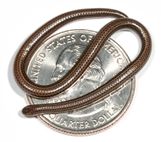|
Smallest snake-Leptotyphlops carlae sets
world record
SAN JUAN, Puerto Rico -- S. Blair Hedges, an evolutionary
biologist at Penn
State University, has discovered a 4 inches long species
of snake-which sets the world record for the smallest species
of snake.
Photo: The snake is small enough to curl up on a
US quarter.
Photo by B.Hedges/ PSU
(enlarge
photo)
"I was thrilled when I turned over that rock and
found it," Dr Hedges told BBC News. "After finding the first
one, we turned hundreds of other stones to find another one."
In total, Dr Hedges and his herpetologist wife found only
two females.
Hedges said the snake, which is so diminutive
it can curl up on a U.S. quarter, is the smallest of the roughly
3,100 known species of snakes.
Hedges, an evolutionary biologist at Penn
State University, said the snake was found slithering
beneath a rock near a patch of Barbadian forest.
The newly identified species, Leptotyphlops
carlae, measures just 3.9 inches long and was found
under a rock on the western Atlantic island of Barbados.
"New and interesting species are still being
discovered on Caribbean islands, despite the very small amount
of natural forests remaining," said Hedges, who christened
the miniature brown snake "Leptotyphlops carlae" after his
herpetologist wife, Carla Ann Hass.
Full-grown adults typically stretch less than
4 inches long.
Two other extremely small snakes, L. bilineatus
from Martinique and L. breuili from Saint Lucia, were identified
nearby, suggesting that the world's three smallest snakes
are all Caribbean threadsnakes.
The Barbadian snake apparently eats termites
and insect larvae, but nothing is yet known of its ecology
and behavior. Genetic tests identified the snake as a new
species, Hedges said. It is not venomous.
This new discovery is described in the journal
Zootaxa.
Hedges previously identified the world's
smallest frog and lizard on Caribbean islands. He explained
that the process of naming the smallest requires measuring
adult individuals -- ideally at least one male and one female
-- and then comparing the average size to all other known
species.
He determined the Barbados threadsnake is
the smallest of more than 3,100 known snakes. The snake may
even be as miniscule as nature could go for snakes since,
if it were any smaller, he believes its young would have nothing
to eat. As it stands, Hedges thinks it primarily consumes
the tiny larvae of termites and ants.
Females of this smallest species produce
just one slender egg. In contrast to larger species that may
lay up to 100 eggs in a single clutch, with each egg measuring
just a fraction of the mother's body, this snake produces
a single hatchling that is half its mother's size.
"The fact that tiny snakes produce only one massive
egg -- relative to the size of the mother -- suggests that
natural selection is trying to keep the size of hatchlings
above a critical limit in order to survive," he explained.
Hedges added that, because of the snake's
small size, "almost anything could be a predator, including
centipedes and spiders."
Researchers believe that the snake - a type
of thread snake - is so rare that it has survived un-noticed
until now.
But with 95% of the island of Barbados now treeless,
and the few fragments of forest seriously threatened, this
new species of snake might become extinct only months after
it was discovered.
Dr Hedges added that the snake's size might
limit the size of its clutch. "If a tiny snake were to have
more than one offspring, each egg would have to share the
same space occupied by the one egg and so the two hatchlings
would be half the normal size."
The hatchlings might then be too small to find
anything small enough to eat. This has led the researchers
to believe that the Barbadian snake is as small as a snake
can evolve to be.
Tuesday, August 5, 2008
|
















